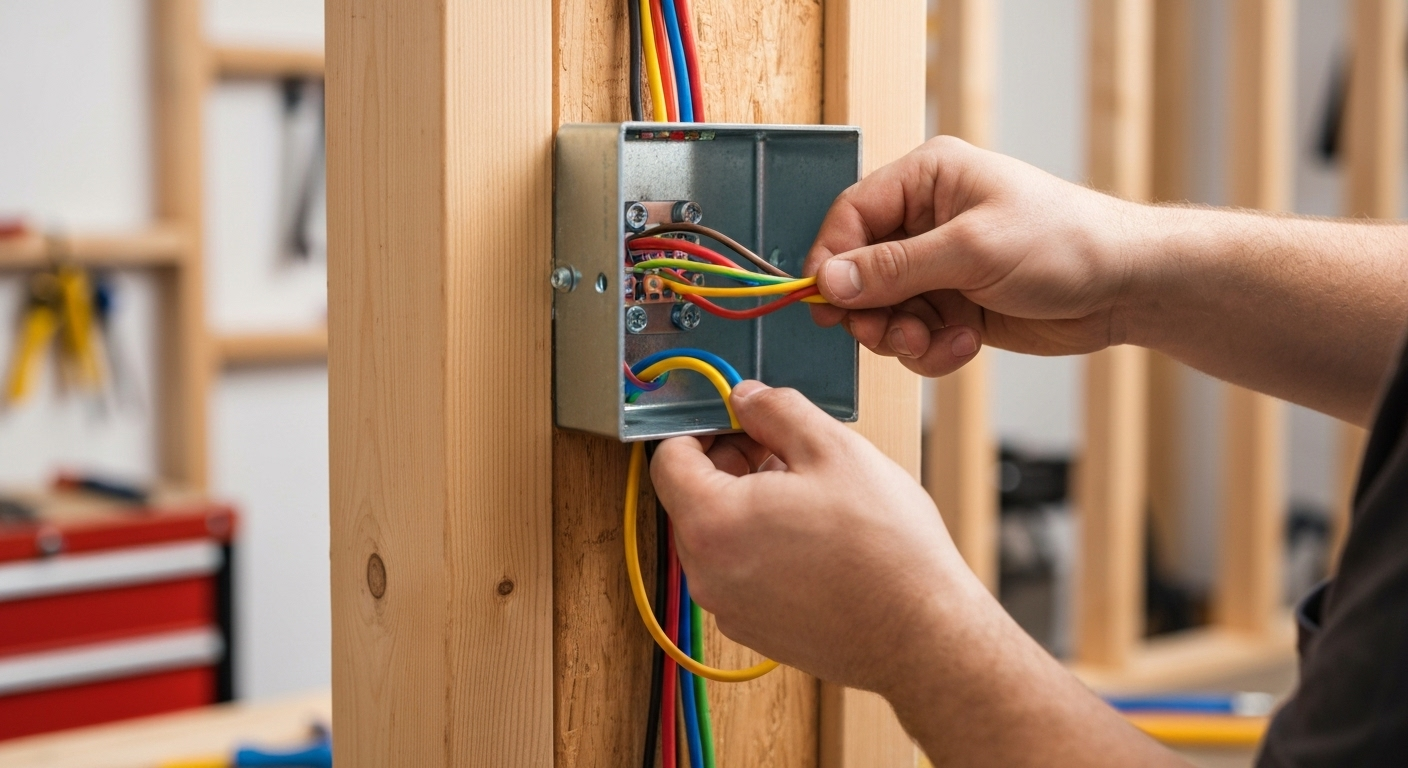
How to Calculate Junction Box Size (NEC 2023 Guide)
Article Summary: Calculating the correct junction box size per the NEC 2023 involves a process known as a “box fill calculation,” primarily governed by NEC Article 314. The first step is to determine the total number of conductor equivalents in the box. This count includes each conductor originating outside the box, a single allowance for all grounding conductors, a single allowance for all internal cable clamps, and a double allowance for each device yoke (like a switch or receptacle). You then calculate the total required volume by summing the volumes for each component. Individual conductors are counted based on their own size per NEC Table 314.16(B), while allowances for clamps and grounds are based on the volume of the largest conductor entering the box, and the device yoke allowance is based on the largest conductor connected to the device. The resulting total cubic inch volume dictates the minimum size of the box required. The box itself must be marked with its volume, or you can find standard volumes in NEC Table 314.16(A).
Understanding NEC Article 314: The Foundation for Box Sizing
As a licensed electrician, ensuring every installation is safe, reliable, and compliant is paramount. A fundamental aspect of this is selecting the correct size for outlet boxes, device boxes, and junction boxes. Overcrowding a box is a serious fire hazard, leading to insulation damage from heat buildup and physical stress on conductors. The National Electrical Code (NEC) provides clear, prescriptive rules to prevent this, primarily within NEC Article 314, “Outlet, Device, Pull, and Junction Boxes; Conduit Bodies; Fittings; and Handhole Enclosures.” This article is the authoritative source for all things related to box fill. Understanding how to perform a proper electrical box calculation based on these rules is a non-negotiable skill for any professional in the field.
The Core of Box Fill: NEC 314.16(B) Volume Allowances
The heart of any standard box fill calculation is determining the total volume required by the components inside the box. NEC 314.16(B) provides a simple but powerful system for this. Instead of calculating the exact physical volume of each wire and device, the Code assigns a volume allowance to each item. When a box contains conductors of different sizes, the volume for each conductor is calculated based on its specific gauge. Allowances for hardware like clamps and grounding conductors are then calculated based on the largest conductor entering the box, while the allowance for a device is based on the largest conductor terminated on it. The key is to correctly identify and sum the volume for all components that contribute to the fill.
Conductor Fill Calculations
According to NEC 314.16(B)(1), each conductor that originates outside the box and is terminated or spliced within the box is counted as one conductor. Conductors that simply pass through without a splice or termination (e.g., in a pull box) are also counted as one conductor. The required cubic inch volume for each conductor is found in NEC Table 314.16(B), “Volume Allowance per Conductor.”
- 14 AWG: 2.00 cubic inches
- 12 AWG: 2.25 cubic inches
- 10 AWG: 2.50 cubic inches
- 8 AWG: 3.00 cubic inches
- 6 AWG: 5.00 cubic inches
Allowances for Devices, Clamps, and Grounding
Beyond the wires themselves, the NEC accounts for other hardware that occupies space:
- Cable Clamps (314.16(B)(2)): A single cable clamp allowance is made based on the largest conductor entering the box. This single count covers all internal clamps, whether there is one or four. External clamps do not count toward box fill.
- Support Fittings (314.16(B)(3)): Items like fixture studs or hickeys count as one conductor allowance based on the largest conductor.
- Device Yoke Allowance (314.16(B)(4)): Each device yoke—the mounting strap for a switch or receptacle—counts as a double (2) conductor allowance based on the largest conductor connected to that device.
- Equipment Grounding Conductor Fill (314.16(B)(5)): A single equipment grounding conductor fill allowance is made for all equipment grounding conductors (EGCs) in the box combined. This is based on the largest EGC present. Understanding grounding is critical, and it’s important to stay current on updates, such as how the 2023 NEC updates impedance grounding system requirements.
Step-by-Step Guide to Calculating Box Fill (NEC 2023)
Let’s walk through a common example: a 2×4 plastic box containing one 12/2 NM cable (power in) and one 12/2 NM cable (power out) supplying a single duplex receptacle. The box has no internal clamps.
- Count Conductors:
- Power In: 1 hot (black), 1 neutral (white) = 2 conductors
- Power Out: 1 hot (black), 1 neutral (white) = 2 conductors
- Total Conductors: 4
- Add Allowances:
- Cable Clamps: The plastic box has no internal clamps. Count = 0.
- Equipment Grounding Conductors: There are two EGCs (one from each cable), but they count for a single allowance. Count = 1.
- Device Yoke: One duplex receptacle is installed. This counts as a double allowance. Count = 2.
- Calculate Total Conductor Equivalents:
- 4 (conductors) + 1 (grounding) + 2 (device yoke) = 7 total allowances.
- Determine Volume per Conductor:
- All conductors are 12 AWG. According to NEC Table 314.16(B), the volume allowance per conductor for 12 AWG is 2.25 cubic inches.
- Calculate Total Required Volume:
- 7 allowances x 2.25 cu. in. = 15.75 cubic inches.
- Select the Box: You must now select a box with a minimum volume of 15.75 cubic inches. Looking at NEC Table 314.16(A), a standard 3 x 2 x 2 ¾ in. device box has 14.0 cu. in., which is too small. A standard 3 x 2 x 3½ in. device box has 18.0 cu. in., making it a compliant choice.
Mastering this calculation is essential for code compliance. For a deeper dive with more complex scenarios, you can learn more with our NEC lessons and ensure your skills are sharp.
Special Considerations: Terminal Blocks and Larger Boxes
While the standard box fill calculation covers most residential and light commercial work, the NEC junction box size 2023 rules include provisions for more complex installations.
Sizing with Terminal Blocks
A significant clarification in the 2023 NEC addresses components like terminal and power distribution blocks. The rules differ based on the component type. For power distribution blocks (PDBs) in boxes over 100 cu. in., the new NEC 314.28(E) applies. It states that the box must be sized to include the required wiring space (per 314.28(A) or (B)) plus the physical volume of the PDB. Essentially, the PDB does not count against the required wiring space, but the box must be large enough to contain both. For other types of terminal blocks, the NEC does not provide a specific volume allowance, meaning their physical volume must be accounted for in addition to the conductor fill. In all cases, the conductors terminating on these blocks still count toward the overall fill calculation.
Pull and Junction Boxes for Conductors 4 AWG and Larger: NEC 314.28
When dealing with conductors 4 AWG and larger, the rules for pull box sizing shift from the volume-based calculations of 314.16 to the dimension-based rules of NEC 314.28. This section is designed to provide adequate space to physically pull and bend large, stiff conductors without damaging their insulation.
- Straight Pull Calculation (314.28(A)(1)): For a straight pull, the length of the box must be at least eight times the trade size of the largest raceway.
- Angle Pull Calculation (314.28(A)(2)): For angle, U, or splice pulls, the distance between where the raceways enter and the opposite wall must be at least six times the trade size of the largest raceway, PLUS the sum of the diameters of all other raceways on the same wall and in the same row.
Primary Sources
This article is based on the requirements found in the 2023 National Electrical Code (NEC), also known as NFPA 70. For official information, please refer directly to the codebook published by the National Fire Protection Association (NFPA).
Key Takeaways for Compliant Installations
Staying current with the NEC is a core part of maintaining your license, a process which often requires specific continuing education hours, such as those for a Texas electrical license renewal. Here are the essential points to remember for compliant box fill:
- Use the Correct ‘Largest Conductor’: Allowances for clamps and grounds are based on the size of the largest conductor entering the box. The allowance for a device yoke is based on the size of the largest conductor connected to that specific device.
- Don’t forget the yoke: A device yoke (receptacle or switch) counts as two conductors. This is a commonly missed item.
- Grounds count as one: All equipment grounding conductors count as a single volume allowance.
- Check the box marking: Per NEC 314.16(A)(2), nonmetallic boxes and other boxes 100 cu. in. or less must be marked with their volume by the manufacturer. If a nonmetallic box is not marked, it is not compliant. The volumes listed in Table 314.16(A) are the minimums for the standard metal boxes described in that table and can be used if those specific boxes are unmarked.
- 4 AWG and Larger is Different: Remember that for large conductors (4 AWG and up), you must switch to the dimensional rules of NEC 314.28 for pull and junction boxes.
- Free Conductor Length: Don’t forget NEC 300.14, which requires at least 6 inches of free conductor at each outlet, junction, and switch point, measured from where it emerges from the raceway or sheath. Where the opening to the box is less than 8 inches in any dimension, at least 3 inches of that free conductor must extend outside the opening. This ensures there’s enough wire to work with safely.
Frequently Asked Questions (FAQ)
What is the basic rule for NEC junction box size in 2023?
The basic rule, found in NEC 314.16, is to sum the number of “conductor equivalents” in a box. This includes current-carrying conductors, one allowance for all ground wires, one for all internal clamps, and two for each device yoke. The total required volume is found by summing the volumes of each component. The volume for each conductor is based on its own size, while the allowances for ground wires and clamps are based on the largest conductor in the box, and the yoke allowance is based on the largest conductor connected to the device. These volumes are listed in NEC Table 314.16(B).
How do you account for a device yoke in a box fill calculation?
According to NEC 314.16(B)(4), each device yoke or strap (such as for a receptacle or switch) counts as a double (two) conductor volume allowance. This allowance is based on the largest conductor connected to that device.
Does an equipment grounding conductor always count as one conductor?
Yes. Per NEC 314.16(B)(5), all equipment grounding conductors (EGCs) and bonding jumpers within a box are counted together as a single conductor volume allowance. This single allowance is based on the size of the largest EGC in the box.
What’s the difference between a straight pull and angle pull calculation for large pull boxes?
This applies to boxes with conductors 4 AWG or larger under NEC 314.28. A straight pull calculation requires the box length to be at least 8 times the trade diameter of the largest raceway. An angle pull calculation is more complex, requiring the distance from the raceway entry to the opposite wall to be at least 6 times the largest raceway’s diameter, plus the sum of the diameters of all other raceways on the same wall.
Continuing Education by State
Select your state to view board-approved continuing education courses and requirements:
Disclaimer: The information provided in this educational content has been prepared with care to reflect current regulatory requirements for continuing education. However, licensing rules and regulations can vary by state and are subject to change. While we strive for accuracy, ExpertCE cannot guarantee that all details are complete or up to date at the time of reading. For the most current and authoritative information, always refer directly to your state’s official licensing board or regulatory agency.



